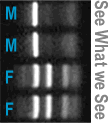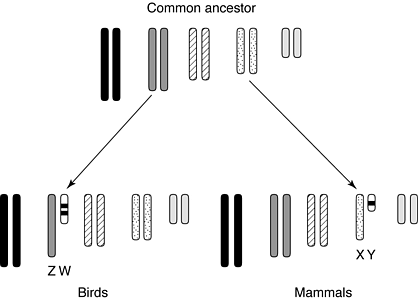tags: birds, bird sex chromosomes, ZZ, ZW, parrots, sex identification, molecular biology
Evolution of Avian and Mammalian sex chromosomes.
Image: E.R.S. Roldan and Montserrat Gomendio "The Y chromosome as a battle ground for sexual selection" Trends in Ecology & Evolution 1999, 14:58-62.
You all are probably curious to know what is happening with my birds these days, so I shall tell you about how sex is identified in birds, such as parrots, where the sexes look the same. But wait a minute, you ask, what does an update about my birds have to do with identifying sex in parrots?
You might recall that my hawk-headed (red-fan) parrot is still formally unnamed because I don't know what sex she is. I have chosen these names for the bird; Persephone if she's a female, Orpheus (thanks to one of my readers) if she's a male. Currently, I refer to her by the unisex name, "Pipsqueek", which will probably remain one of her (his?) nicknames for life.
Anyway, I am solving the problem of identifying the bird's sex today. About one hour ago, I clipped one of "Pipsqueek's" toenails into the quick to collect some blood so I can mail it to Avian Biotech today. After they receive the specimen, they will isolate the DNA from the red blood cells (RBCs) -- unlike mammalian RBCs, bird RBCs contain nuclei, which contain DNA. After isolating the DNA, they will perform a PCR test that selectively amplifies a specific region on the bird's sex chromosomes by a million-fold. This PCR product is then run on an agarose or polyacrylamide gel which separates the amplified DNA fragments based on their sizes -- the larger the DNA fragment, the slower it moves (when in grad school and working as a postdoc, I used to "sex" my own birds and anyone else's who provided bird blood for me to use, so I am very familiar with this technique). The results look something like this (right). 
These PCR results show two distinct DNA "bands" for female birds (F) and one for males (M). This is because the sex of birds is genetically determined oppositely from mammals. Female birds are the heterogametic sex, meaning that they possess two sex chromosomes, known as "ZW", that are different from each other, whereas male birds are the homogametic sex, possessing two identical Z chromosomes. When a small portion of these sex chromosomes are PCR amplified, they provide either one or two differently-sized DNA fragments, which are easily detected on a gel, thus providing a quick and easy method to identify sex in birds.
"Pipsqueek" has probably not experienced much pain in her short life, so she sat very quietly (uncharacteristically so) in my lap while I wrote this to you. I feel bad for hurting her. However, now that I have finished writing this entry for you, she appears to have recovered from her upset because she is now busily trying to rip the pocket off the seat of my jeans after chewing a hole in my bathtowel.
- Log in to post comments


Another option to the blood method is feather sexing, and is painless. That's how I sexed Pepper when he was a wee bird, I just took one of his feathers that had naturally fallen out (more recently the better). He's male by the way.
I have a little green-cheek (Eutychus, which is a male name) and the breeder told me 80% of them born in captivity are male. I "sexed" her by finding an egg in her cage one morning. At first I thought my roommate was playing a trick on me!
That's very interesting, BTW, about the ZW thing. For us non-biologists, when we hear about how something works we sometimes just kinda assume it works that way all over the place. And now I'm remembering that scene in Jurassic park where they talk about the sex controls on the dinosaurs... Hmm...
All I know is that this is not the way to find an animals gender.
http://darwinawards.com/personal/personal2002-22.html
i waited and waited for a few feathers to fall out, but the bird is so young that she's just not going to drop any feathers any time soon. i then thought i'd pull a few feathers out (this is painless to the bird, unless you pull a "blood feather"; a newly growing feather that still has a blood supply), but i have a very strong aversion to pulling feathers out of birds. i've done it when it was necessary, but ..
having done surgery on a fair number of birds for my dissertation work, i find that blood doesn't bother me nearly as much as feather-ripping.
There's this crazy idea that the ancestral state of sex chromosomes in amniotes is a chain of X chromosomes (like that in monotremes). one end of the monotreme chain is homologous to the eutherian X and the other end is homologous to the avian X. The problem with that is that a lot of reptiles don't have sex chromosomes.
Hi.
I had a long discussion with a friend who owns a DNA lab in Texas.
He told me that the procedure mentiond above works about 96% of the time.
In the other 4% it doesn't.
I wasn't really able to follow where the problem happens but it is something to do with the bird, not the technology.
Coments?
Regards, Jim
Wow, that's so cool. I used to have two lovebirds, and we never found out what sex they were (R.I.P., little ones). I had no idea bird RBC's had nuclei.
Anyway, if humans have to go through all the trouble of taking blood or feathers from the birds (about the feathers, I guess they must have the "root" too?), how do THEY know which sex a potential partner is? Surely they have to be able to tell relatively easy? Otherwise it would be very very confusing...
The sex-determination stuff is also VERY interesting. I've wondered exactly how it evolved ever since I first learned about the different types. I know some insects use ZW, others XY, otheres X0 (or whatever it's called), and so on. Is there any chance of a blog post about sex determination methods and their evolution any time soon?
Barring the science talk, Feather sexing is simplest if (species relevent)available. However, If you take the time to really, really observe your birds you can understand their behaviors and along with appearance can visually sex them. Male birds(parrots)when mature, often masturbate on their perches. There are differencs in head shapes that are obvious to sexes ie: Male amazon parrots have block heads. The Collared Lory you post on your banner can easily be sexed by the amount of red feathers between the nape and back. Males have a subtle but significantly larger gap between the feathers. Experience is really the key to awareness in sexes. The more you see, the more aware you become. Tammy
Thats interesting, since the breeder I got my African Grey from said she was 90% sure he was male when she sold him to me. Sure, she's got a 50-50 chance of a good guess, but she had guessed from behavior/appearance before with other people I talked to and was almost always right (8/10). Among other things, she mentioned that male Greys usually had more red feathers around their vent then female birds. Also, the male birds she had were *Very* good talkers while the females were just average. I sexed Pepper at about 5 months and while he didn't utter his first word until 1 year old, he ended up being the best talker she'd had.
when i was breeding and hand-rearing lories and other parrots, i also was able to identify the sexes quite accurately. however, the relationship that i had with my baby parrots was very close; i don't expect that i can identify the sex of a parrot that landed in my life less than one month ago based on visuals and behavior alone when we are still getting to know each other!
actually, based on my own experience breeding hawk-headed parrots, i think this bird is female based on her plumage patterns; female hawk-headed parrots have more red on their breast feathers while the males have more blue. of course, this is a very subtle distinction and not only that, but juvenile birds, such as "Pipsqueek", who is only five months old, typically resemble females of the species rather than the males, so plumage characters are really bad for identifying sex in immature birds.
so, in a word, i could very well be WRONG, and Persephone could be Orpheus!
jim; you raise an interesting point. it is true that DNA sexing doesn't work for all birds; most notably, the ratites. in fact, ratites (birds such as ostriches, rheas, etc.) do not even have distinct sex chromosomes!
i am going to follow up your point further because i think i will write a longer series of essays for my blog about sex determination in animals.
ratites (birds such as ostriches, rheas, etc.) do not even have distinct sex chromosomes!
I was under the impression that they have distinct ZW chromosomes, only the chromosomes aren't morphologically differentiated.
Also, my comment above should have read "the other end is homologous to the avian Z".
I found this information on sexing parrots very interesting, especially since I am a breeder of parrots. What I have been curious about is this: What influences the final determination of the sex? I noted in #2 comment by Pough that the breeder told him that 80% of parrots born in captivity are male. I have also heard that. However, this year my clutches of chicks have turned out to be predominently Female, and I have been wondering why? I wonder if there were some factors in their environment that we are unaware of manipulating that is causing this change in the norm. It would be nice to be know what those factors are.
Thanks for any light you might be able to shed on this mystery (at least to me.)
CactusLil
Hi.
As for 80% females in captivity?
I would question this observation.
To start: Why only in captivity?
My experience is species dependent, year dependent and just plain old luck.
As for Devorah's favorite lories? I have problems finding males far more often than females.
Statistically one needs to keep track of a whole lot of birds over many years to come to such a conclusion.
Regards, Jim - also a breeder
Does anyone know why canaries cannot be DNA sexed?